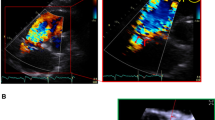Abstract.
The proximal isovelocity surface area (PISA) method for calculating volume flow through the regurgitant orifice has attracted significant attention. A number of in vitro studies and clinical studies in adults suggest that the method is accurate. However, when applying the method to children it must be noted that the absolute regurgitation volume is small, and the range of body sizes is wide. This study investigated the accuracy of the PISA method for quantitative assessment of the severity of mitral regurgitation in children. Twenty children aged 7 months to 12 years (average 4.7 years) with mitral regurgitation but without interventricular shunt or aortic stenosis were selected for this study. Underlying cardiac diseases included atrioventricular septal defects in nine, isolated mitral regurgitation in five, and association with other heart defects in six. The PISA radius (r) and the duration of regurgitation (T) were measured on color M-mode recordings, with the M line passing through the center of the PISA. Assuming that the PISA is a hemisphere, maximal regurgitant flow rate (MFR: ml/s) was calculated as MFR = 2π×~ r 2×~ V (r= maximal radius, V= aliasing velocity), and regurgitant stroke volume (RSVpisa) as RSVpisa = 2π×~ MSR ×~ V×~ T (MSR = mean square of the PISA radius during regurgitation). As a validating standard, total stroke volume (TSV) using two-dimensional echocardiography determined by the area–length volumetry method and forward stroke volume (FSV) by the pulsed Doppler method were measured, and regurgitant stroke volume (RSVD: RSVD= TSV − FSV) and regurgitant fraction (RF: RF = RSVD/TSV) were calculated. A linear correlation was found between MFR, RSVpisa, and RSVD (X) (MFR = 4.2X + 54.0, r= 0.84. RSVpisa = 1.0X + 9.8, r= 0.90), and both RSVpisa and MFR divided by body surface area (BSA: m2) revealed a significant correlation with regurgitant fraction (X) by nonlinear regression analysis (RSVpisa/BSA = 26.2 ×~ X/(1 − X) + 16.8, r= 0.85. MFR/BSA = 121.8 ×~ X/(1 − X) + 92.2, r= 0.79). It is concluded that maximal regurgitant flow rate, regurgitant stroke volume, and regurgitant fraction can be accurately predicted in children using the PISA method by Doppler echocardiography.
Similar content being viewed by others
Author information
Authors and Affiliations
Rights and permissions
About this article
Cite this article
Aotsuka, H., Tobita, K., Hamada, H. et al. Validation of the Proximal Isovelocity Surface Area Method for Assessing Mitral Regurgitation in Children. Pediatr Cardiol 17, 351–359 (1996). https://doi.org/10.1007/s002469900079
Issue Date:
DOI: https://doi.org/10.1007/s002469900079




